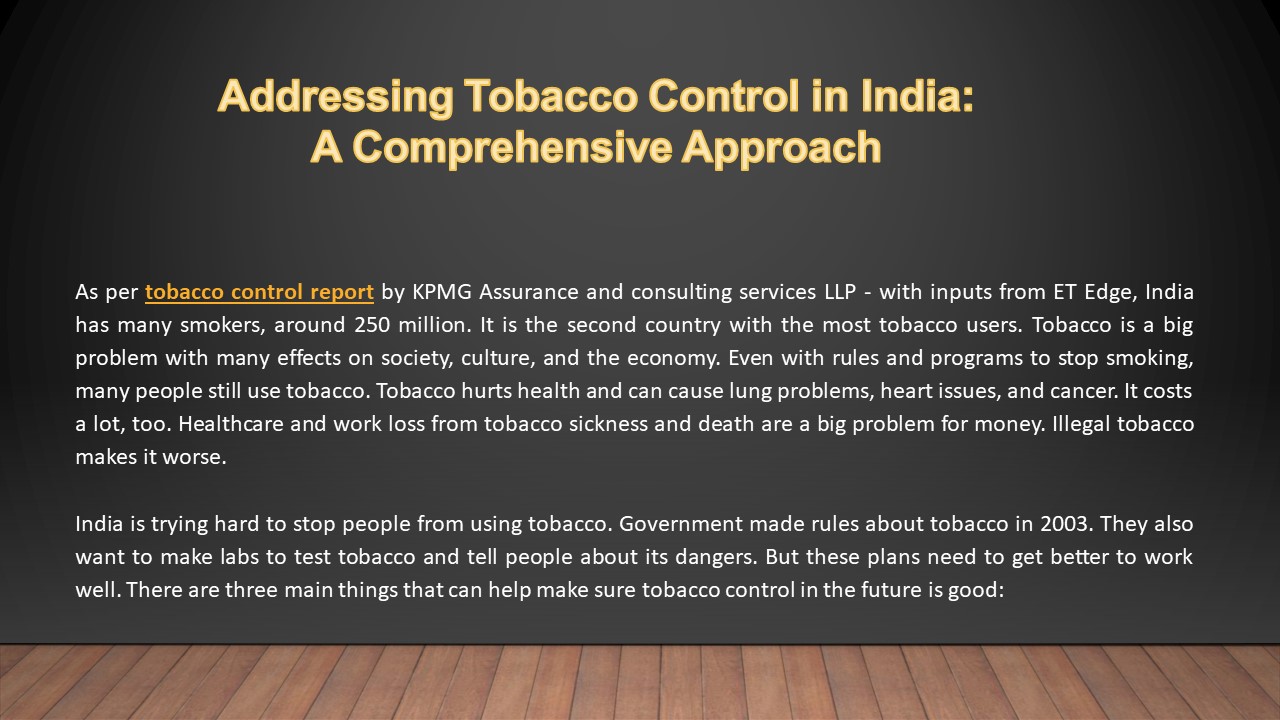Addressing Tobacco Control in India: A Comprehensive Approach PowerPoint PPT Presentation
Title: Addressing Tobacco Control in India: A Comprehensive Approach
1
Addressing Tobacco Control in India A
Comprehensive Approach
As per tobacco control report by KPMG Assurance
and consulting services LLP - with inputs from ET
Edge, India has many smokers, around 250 million.
It is the second country with the most tobacco
users. Tobacco is a big problem with many effects
on society, culture, and the economy. Even with
rules and programs to stop smoking, many people
still use tobacco. Tobacco hurts health and can
cause lung problems, heart issues, and cancer. It
costs a lot, too. Healthcare and work loss from
tobacco sickness and death are a big problem for
money. Illegal tobacco makes it worse. India is
trying hard to stop people from using tobacco.
Government made rules about tobacco in 2003. They
also want to make labs to test tobacco and tell
people about its dangers. But these plans need to
get better to work well. There are three main
things that can help make sure tobacco control in
the future is good
2
1. Stopping People from Starting to Use
Tobacco Most people start using tobacco when they
are young. We need to teach young people about
the dangers of tobacco, using TV, internet, and
other ways. We also need to make sure that young
people can't buy tobacco. 2. Helping People to
Quit Using Tobacco There are medicines that can
help people stop using tobacco. If more people
know about these medicines and get help from
their doctors, it can help them quit. Talking to
someone about quitting can also help. 3. Making
It Safer for People Who Can't Quit For people who
can't stop using tobacco, e-cigarettes can be a
safer choice. They are not totally safe, but they
are better than smoking. We need rules for making
e-cigarettes with less bad stuff in them. This
can reduce the harm they cause. While the health
risks of tobacco are well established, the
solutions are nuanced owing to the complex
socioeconomic factors underlying its use. Tobacco
is entrenched in the social and cultural fabric
of many communities. It is important to
acknowledge these complexities and avoid a
strictly prohibited approach.
3
People who are neither intractable nor unable to
quit after previous attempts are considered very
important for harm reduction. E cigarettes are an
alternative offering with fewer toxins than
combustible cigarettes. Nevertheless, it is fair
to say that law enforcement is important.
Manufacturers should be encouraged to produce
less toxic products, as well as keep the younger
generation informed and e-cigarettes should not
be mistaken for total safety. Through tax
credits, e-cigarettes are affordable so people
can smoke them up and campaigns with
science-based facts can make the public aware of
relative risk compared to traditional tobacco
cigarettes. The novel nicotine-based
replacements, including herbal cigarettes and
non-nicotine chewing forms of indoor tobacco also
deserve experimentation, only in the presence of
regulatory supervision. The conduction of a
nationwide survey on the willingness to use the
alternative sectors for narcotics can educate the
policies on the same. In addition we have to be
cautious of nicotine delivery system products,
through mistaken assumptions.
4
The structural aspects of tobacco cultivation and
trade require attention. Switching to alternative
crops could economically empower
tobacco-dependent farmers. The growing illicit
trade must also be monitored - technologies such
as blockchain could help law enforcement agencies
track tobacco products. Collaboration is key to
the best tobacco control solutions - government,
public health experts, manufacturers, researchers
and community partners must work together to find
context-specific solutions. We need a NUANCED,
HUMANE approach - innovative solutions using
technology, understanding through research,
feedback and insights, Nudging through
behavioural finance, community engagement,
engagement with stakeholders is done, data-driven
planning, problem reduction for risk reduction,
empathy in policy making, more - across
departments, accountability in governance and
structure, concept of equity and of justice, with
a focus on individual dignity, compassionate
support systems, evidence-based decision-making.
Through concerted efforts guided by these
principles, India can effectively control the
public health burden of tobacco.
5
(No Transcript)
6
Collaborative, multi-layered strategies,
including initiation, termination, and loss
reduction are needed. Targets should be
implemented gradually - first focusing on
reducing disease burden through toxicity
reduction, then emphasising cessation. Tobacco is
firmly woven into the socio-economic fabric, so
finding the best solution requires nuance - not
just pursuing total abstinence. Indian tobacco
control programs can successfully deliver on
their public health objectives by adopting this
balanced human-centred approach. In summary,
this blog highlights the need for a comprehensive
tobacco control strategy in India that goes
beyond legislation and cessation efforts. A
collaborative approach focused on preventing
tobacco initiation, promoting cessation, and
acknowledging harm reduction is key to
effectively addressing tobacco use disorders.
7
Thank You

